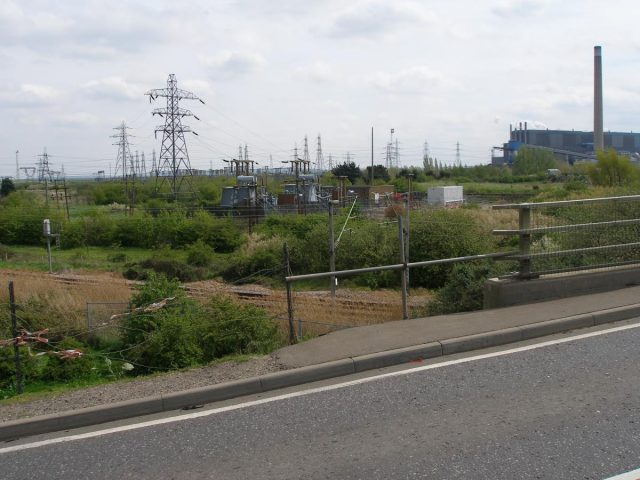Swanscombe Marshes
Swanscombe Marshes, on the Swanscombe Peninsula in Kent is home to a remarkable mosaic of grasslands, coastal habitats, brownfield features, scrub and intricate wetlands.
In July 2020 The London Resort launched a public consultation to canvas the views of all stakeholders regarding their plans to concrete over Swanscombe Peninsula to allow the building of a theme park. Buglife once again sprang into action with a high profile campaign; working with vocal community groups and other conservation charities.
In 2022 the Planning Application was withdrawn by London Resort prior to the start of the Preliminary Meeting; but the fight to save this haven of biodiversity is far from over. London Resort plan to resubmit the application for development later in the year; so we will continue to call on the government to do everything it can to step in and save the nature haven.
To find out more and read the story so far visit: Save Swanscombe Marshes
![]() Swanscombe Marshes © Diamond Geezer
Swanscombe Marshes © Diamond Geezer Tilbury 2
The former Tilbury Power Station supported a rich mosaic of habitats that have established on the underlying Pulverised Fuel Ash (PFA), Lytag and diverse substrates resulting its industrial history. The unique combination of drought stressed grasslands, lichen heath, herb, lichen-rich grasslands and scrub were home to nearly 1,400 species of invertebrate, including 159 species of conservation concern and 31 species identified as rare or threatened. This included the Shrill Carder Bee (Bombus sylvarum), Sea Aster Mining Bee (Colletes halophilus) and Five-banded Weevil-wasp (Cerceris quinquefasciata).
However, in 2017 an application as made to expand the Port of Tilbury as a Nationally Significant Infrastructure Project called Tilbury 2, to create a new port terminal on this wildlife haven. In 2017, Buglife started a campaign to stop the Tilbury 2 proposals and nearly 75,000 people signed a petition, which was submitted to the Planning Inspectorate. Sadly, in 2019, the Secretary of State gave the project the green light and the site has now been largely destroyed as the port plans progress.
This was despite Natural England describing the site as being “of sufficient quality to meet the designation requirements of a Site of Special Scientific Interest (SSSI)” and stating publicly that” Natural England will be adding the site to our designations’ pipeline, consistent with the requirements of our designations’ strategy.”
West Thurrock Marshes
West Thurrock Marshes, in South Essex is, quite simply, one of the UK’s best sites for rare bugs and other wildlife. It is home to dozens of species of conservation concern, including the Hornet Robberfly (Asilus crabroniformis), Fancy-legged Fly (Campsicnemus magius), Brown-banded Carder Bee (Bombus humilis) and the Saltmarsh Shortspur Beetle (Anisodactylus poeciliodes). It is also one of only two sites for the Critically Endangered Distinguished Jumping Spider (Attulus distinguendus). The site supports a nationally important mosaic of bare ground, flower-rich grassland, scrub and saltmarsh that has developed on the Pulverised Fuel Ash (PFA) that was once spread across the site when it housed an active power station.
Back in 2006, a damaging planning application was approved for warehousing and a lorry park on the site. Buglife sprang into action with a high profile campaign lasting two years, until unfortunately we lost the case in the Court of Appeal. Although part of the West Thurrock Marshes has gone to development, the majority of this wonderful brownfield site is now safe and its long term management secured – a great outcome for bugs!
40 hectare site, sometimes referred to as Oliver Road Lagoons is now managed by the Essex Wildlife Trust, thanks to a partnership between the new land owners The Land Trust, developer Goodman and Natural England. This has seen 7 hectares of established scrub cleared to restore the important open PFA habitats needed by some of our rarest and most threatened invertebrates.
![]() West Thurrock Marshes © Greg Hitchcock
West Thurrock Marshes © Greg Hitchcock The Thames Gateway – ‘England’s rainforest’ in the firing line
Thames Gateway brownfields are havens for wildlife, supporting nationally important populations of rare and scarce invertebrates, including those found nowhere else in the UK. The importance of brownfields is being increasingly recognised to address the biodiversity crisis, as they are often the last refuges in an increasingly managed landscape and provide linkages between other more traditional habitats.
However, Thameside brownfields are increasingly under pressure from development, as industry and housing sprawls along the estuary.
Between 2005 and 2008, Buglife collaborated with English Nature (now Natural England) on the ‘All of a Buzz in the Thames Gateway’ project, mapping and assessing brownfields across the region, finding that over 40% had the potential to support threatened invertebrates. In 2013, the ‘State of Brownfields in the Thames Gateway’ set out to investigate the subsequent scale of loss of these wildlife-rich brownfields, using up-to-date aerial images and site visits. Shockingly, over half had been either destroyed or had an outstanding planning permission in this short period of time.
Sadly, the losses continue, with nationally important brownfield sites continuing to be under threat.
![]() Canvey Wick © Claudia Watts
Canvey Wick © Claudia Watts 




